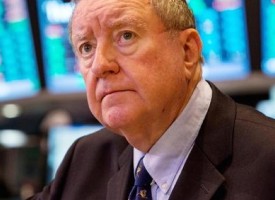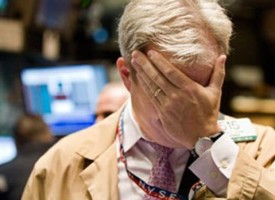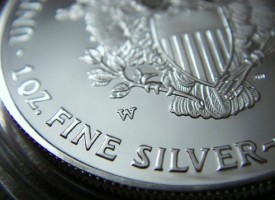On the heels of the recent turmoil in global markets, Gerald Celente just warned these wild cards can crash global equities and economies.
THE WILD “BUBBLE” CARD
May 24 (King World News) – While the media continues to blame any retraction and future fears of downturns in economies and equities on the trade wars and tariffs, among the greater fears barely reported is the $250 trillion debt bubble that keeps growing that has inflated equities and expanded economies.
The International Monetary Fund has warned that high corporate debt has spread to 70 percent of the global economy and “There are growing signs that this credit cycle may be maturing and risks of an economic slowdown are rising.” Singling out the U.S. and China as the most vulnerable, they warned that companies continue to borrow more even as profitability falls…
BONUS INTERVIEW:
To listen to Doug Casey’s just-released KWN interview discussing his prediction of financial and economic chaos and a panic into gold CLICK HERE OR BELOW:
Further debt-bubble warnings were issued by Bain Capital, whose co- managing partner, Johathan Lavine noted that “increasingly aggressive” private equity groups were taking on heavy debt to win merger and acquisition deals, heightening the risk of a crash in the sector in the event of a sharp market downturn.
Therefore, should interest rates rise, so will the debt burden. Thus, the prospects for higher rates remain negligible.
WHAT A DIFFERENCE A QUARTER MAKES
On 19 September 2018, the day before the S&P hit a record high, we had forecast an “Economic 9/11” would sink stock markets. We based our forecast on stated Federal Reserve policy to aggressively raise interest rates through 2019.
Perfectly on-trend, equity markets across the globe tanked, many sinking over 20 percent into bear territory following our forecast. In fact, the Dow had its worse December since the Great Depression.
However, we did a 180-degree turn, reversing our “Economic 9/11” forecast to a “Trump Market Bump” following U.S. Federal Reserve chairman Jerome Powell’s rate hike U-turn on 4 January when he pledged to be “patient” in raising rates in 2019. Subsequently, by the end of April, the S&P 500 and Nasdaq rallied to record highs.
Immediately after the Fed signaled its high probability of no rate increase this year, central banks and governments began shooting new rounds of monetary methadone into their financial systems to help counter slowing economic growth by lowering interest rates (if they had room to), implementing more quantitative easing provisions, lowering loan standards and/or spend on infrastructure projects.
GLOBAL ECONOMIC SLOW DOWN?
In April, China’s retail sales growth slumped to a 16-year low. But in Europe, consumer spending increased between 0.3 and 0.7 percent in the larger countries. And in the U.S., consumer spending grew 0.9 percent in March. Although it was the biggest gain in nearly a decade, inflation pressures remained low and incomes increased only 0.1 percent.
Thus, consumers are spending more while wages remain stagnant and debt burdens grow heavier. Considering that Federal Reserve found that 40 percent of Americans couldn’t afford a $400 emergency, when the next economic crisis strikes it will hit with Great Depression implications.
And while first-quarter 3.2 percent GDP growth in the U.S. was impressive, much of it was the result of sharp increases in exports and not imports, a far better economic indicator of consumer and business growth.
And Europe’s GDP number comes at a time when business confidence in the EU sunk to a 5-year low, as did industrial sector confidence, according to the European Commission.
THE WILD “OIL” CARD
Should geopolitical tensions in the oil-rich Middle East and Venezuela dramatically escalate, the socioeconomic fallout will be felt across the globe.
Despite U.S.-led attempts to oust Venezuelan President Nicholas Maduro from office have failed, we forecast the stage for war has been set. And we also have forecast the U.S. will continue to ramp up pressure against Iran. Indeed, both oil-rich nations are deeply suffering from the economic warfare (i.e., sanctions) imposed by America.
Thus, when tensions increase and oil prices sharply spike as a result, the already fragile global economy will be hit hard by rising costs at the pump. In the USA, gasoline has been on a steady rise this year, averaging $2.97 a gallon on May 1. And for oil-dependent nations whose currencies are declining as the dollar stays strong, the rising cost of petro-dollar based energy will dampen economic and equity market growth.
And while new rounds of heightened violence that recently erupted between Israel and the Palestinians have subsided, this never-ending tinder box is always ready to explode. Further, Israel’s continued bombings and missile attacks against Syria plus the worsening Saudi-United/Arab Emirates four year Yemen War against the Houthi faction (who they claim is supported by Iran but Houthi’s and Iran deny), are major Middle-East destabilizing factors with the potential to dramatically affect oil prices. TJ
TREND FORECAST
Should war expand in Venezuela and the Middle East and oil prices rise above $100 per barrel, gold prices will spike sharply higher as economies and equities tumble and investors seek safe haven assets.
On the economic and equity market fronts, “It’s interest rates, stupid.”
While taught in school and parroted by politicians and the media that central bank’s monetary policy decisions are not subject to approval, be it India, Turkey, the U.S. etc., constant attacks by nation’s leaders do not fall on deaf ears.
Indeed, as global economies weaken politicians will pressure their central banks to lower rates in hopes of propping up sinking markets and economies… and their popularity ratings when up for re-election.
We forecast that as the U.S. economy slows later this year and next, the Fed will be under pressure to lower interest rates as needed to maintain strong economic, equity and real estate markets throughout the 2020 election cycle. While the U.S. federal fund rate at 2.5 percent is still low by historical standards despite the Fed having raised them nine times since 2015, it can lower them nine times.
We also forecast modest gains in stock markets this year as more cheap money/stimulus measures are implemented, thus pushing sidelined speculators back into equities and, in turn, moderately increasing trading volume. Equity market growth will also be limited since we forecast U.S. corporate earnings are approaching peak levels.
The Trends Journal continues to stress that these artificially induced stimulus measures are temporary, not only inflating the $250 trillion global debt bubble, as noted, they have left economies and business vulnerable to wild card events that could send markets into a tailspin and economies into depression.
Therefore, considering the current events forming future trends, despite attempts by central banks to boost economies, a global slowdown will ensue and recessionary pressures will accelerate.
From China to Europe, from Australia to Argentina, the hard numbers in sinking exports, slumping housing prices, rapidly expanding collateralized loan obligations, GDP growth retracting, real wages falling, personal debt and government debt rising, geopolitical instability… the socioeconomic warning signs will be brightly flashing recession/depression by late 2020.
***KWN has now released the powerful audio interview with Gerald Celente where he discusses trend forecasts for the back half of 2019 and you can listen to it by CLICKING HERE OR ON THE IMAGE BELOW.
***Also just released: Silver And Copper Seeing Extreme Readings. Look For A Sharp Rebound In Prices CLICK HERE TO READ.
© 2019 by King World News®. All Rights Reserved. This material may not be published, broadcast, rewritten, or redistributed. However, linking directly to the articles is permitted and encouraged.









